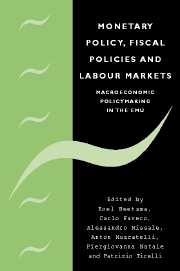Book contents
- Frontmatter
- Contents
- List of figures
- List of tables
- List of contributors
- Acknowledgements
- Editors' introduction
- Part I Monetary policy
- Part II Fiscal policies
- 5 The interaction between monetary and fiscal policies in a monetary union: a review of recent literature
- 6 Independent or coordinated? Monetary and fiscal policy in EMU
- 7 Interaction of fiscal policies in the euro area: how much pressure on the ECB?
- 8 The macroeconomic impact of different speeds of debt stabilisation in EMU
- 9 Fiscal shocks and policy regimes in some OECD countries
- 10 Monetary and fiscal policy interactions over the cycle: some empirical evidence
- Part III Labour markets
- Index
9 - Fiscal shocks and policy regimes in some OECD countries
from Part II - Fiscal policies
Published online by Cambridge University Press: 22 September 2009
- Frontmatter
- Contents
- List of figures
- List of tables
- List of contributors
- Acknowledgements
- Editors' introduction
- Part I Monetary policy
- Part II Fiscal policies
- 5 The interaction between monetary and fiscal policies in a monetary union: a review of recent literature
- 6 Independent or coordinated? Monetary and fiscal policy in EMU
- 7 Interaction of fiscal policies in the euro area: how much pressure on the ECB?
- 8 The macroeconomic impact of different speeds of debt stabilisation in EMU
- 9 Fiscal shocks and policy regimes in some OECD countries
- 10 Monetary and fiscal policy interactions over the cycle: some empirical evidence
- Part III Labour markets
- Index
Summary
Introduction
The relevance of fiscal policy has been recently revived by both institutional decisions and recent empirical findings.
On the institutional ground, the celebrated Stability Pact represents the most important reference for all European governments. At the same time, the US government has been implementing fiscal policy measures that took into consideration the objective of the balanced budget. One question can then be raised: are governments surrendering an effective tool of macroeconomic stabilisation by obeying automatic rules like those of the Stability Pact or a general balanced-budget objective?
From the theoretical point of view, the literature on non-Keynesian effects of fiscal policy (initially inspired by Giavazzi and Pagano 1990) has shown that fiscal adjustments are able to bring about expansionary effects on the economy when they strongly affect private expectations. In particular, although fiscal policy may be restrictive in the traditional sense, when the fiscal restriction is implemented so as to credibly correct an intertemporal disequilibrium, private expectations may overturn the initial restrictive impact of fiscal contractions and induce an increase in economic activity.
Important case studies (such as Ireland, Denmark, Sweden, etc.) have also shown that these effects can actually occur and that they may depend on many different characteristics (for instance intensity and time length of the fiscal adjustment, etc.).
- Type
- Chapter
- Information
- Monetary Policy, Fiscal Policies and Labour MarketsMacroeconomic Policymaking in the EMU, pp. 224 - 255Publisher: Cambridge University PressPrint publication year: 2004
- 2
- Cited by



